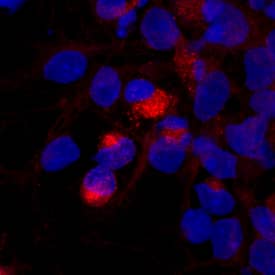Human Brevican Biotinylated Antibody
R&D Systems, part of Bio-Techne | Catalog # BAF4009


Key Product Details
Species Reactivity
Human
Applications
Immunocytochemistry, Western Blot
Label
Biotin
Antibody Source
Polyclonal Sheep IgG
Product Specifications
Immunogen
Mouse myeloma cell line NS0-derived recombinant human Brevican isoform 1
Asp23-Pro911
Accession # AAH27971
Asp23-Pro911
Accession # AAH27971
Specificity
Detects human Brevican in Western blots.
Clonality
Polyclonal
Host
Sheep
Isotype
IgG
Scientific Data Images for Human Brevican Biotinylated Antibody
Brevican in Rat Cortical Stem Cells.
Brevican was detected in immersion fixed rat cortical stem cells differentiated for 7 days by growth factor withdrawal using Sheep Anti-Human Brevican Biotinylated Antigen Affinity-purified Polyclonal Antibody (Catalog # BAF4009) at 10 µg/mL for 3 hours at room temperature. Cells were stained using the NorthernLights™ 557-conjugated Streptavidin (red; Catalog # NL999) and counterstained with DAPI (blue). Specific staining was localized to cytoplasm. View our protocol for Fluorescent ICC Staining of Stem Cells on Coverslips.Applications for Human Brevican Biotinylated Antibody
Application
Recommended Usage
Immunocytochemistry
5-15 µg/mL
Sample: Immersion fixed rat cortical stem cells differentiated for 7 days by growth factor withdrawal
Sample: Immersion fixed rat cortical stem cells differentiated for 7 days by growth factor withdrawal
Western Blot
0.1 µg/mL
Sample: Recombinant Human Brevican (Catalog # 4009-BC)
Sample: Recombinant Human Brevican (Catalog # 4009-BC)
Formulation, Preparation, and Storage
Purification
Antigen Affinity-purified
Reconstitution
Reconstitute at 0.2 mg/mL in sterile PBS.
Formulation
Lyophilized from a 0.2 μm filtered solution in PBS with BSA as a carrier protein.
Shipping
The product is shipped at ambient temperature. Upon receipt, store it immediately at the temperature recommended below.
Stability & Storage
Use a manual defrost freezer and avoid repeated freeze-thaw cycles.
- 12 months from date of receipt, -20 to -70 °C as supplied.
- 1 month, 2 to 8 °C under sterile conditions after reconstitution.
- 6 months, -20 to -70 °C under sterile conditions after reconstitution.
Background: Brevican
N‑terminal fragment increase during remodeling after excitotoxic injury (11, 12). Human brevican shares 90%, 80%, and 80% aa sequence identity with bovine, mouse, and rat brevican, respectively. Within the Ig‑like and two link domains, brevican shares 45%‑51% aa sequence identity with aggrecan, neurocan, and versican.
References
- Viapiano, M.S. and R.T. Matthews (2006) Trends Mol. Med. 12:488.
- Gary, S.C. et al. (2000) Gene 256:139.
- Jaworski, D.M. et al. (1994) J. Cell Biol. 125:495.
- Seidenbecher, C.I. et al. (1995) J. Biol. Chem. 270:27206.
- Hamel, M.G. et al. (2005) J. Neurochem. 93:1533.
- Ogawa, T. et al. (2001) J. Comp. Neurol. 432:285
- Yamada, H. et al. (1997) J. Neurosci. 17:7784.
- Seidenbecher, C.I. et al. (2002) J. Neurochem. 83:738.
- Matthews, R.T. et al. (2000) J. Biol. Chem. 275:22695.
- Nakamura, H. et al. (2000) J. Biol. Chem. 275:38885.
- Mayer, J. et al. (2005) BMC Neurosci. 6:52.
- Yuan, W. et al. (2002) Neuroscience 114:1091.
- Deepa, S.S. et al. (2006) J. Biol. Chem. 281:17789.
- Jaworski, D.M. et al. (1999) Exp. Neurol. 157:327.
- Viapiano, M.S. et al. (2005) Cancer Res. 65:6726.
- Viapiano, M.S. et al. (2003) J. Biol. Chem. 278:33239.
Long Name
Brain Specific Proteoglycan in the Aggrecan Family
Alternate Names
ALPBRE, BCAN, BEHAB, CSPG7
Gene Symbol
BCAN
UniProt
Additional Brevican Products
Product Documents for Human Brevican Biotinylated Antibody
Product Specific Notices for Human Brevican Biotinylated Antibody
For research use only
